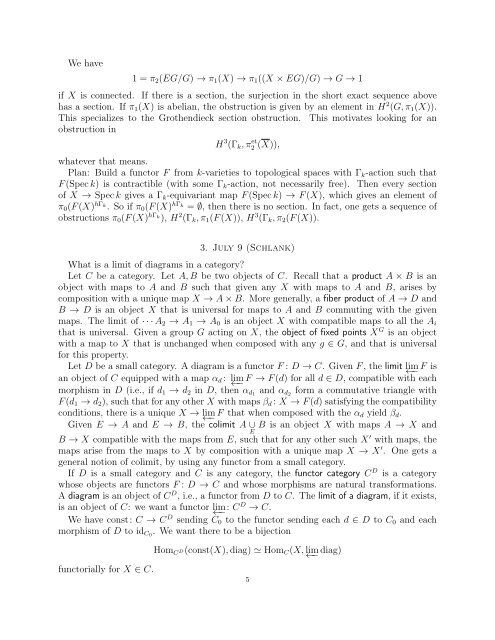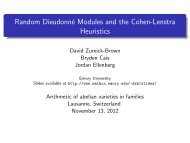alternative lecture notes - Rational points and algebraic cycles
alternative lecture notes - Rational points and algebraic cycles
alternative lecture notes - Rational points and algebraic cycles
Create successful ePaper yourself
Turn your PDF publications into a flip-book with our unique Google optimized e-Paper software.
We have<br />
1 = π 2 (EG/G) → π 1 (X) → π 1 ((X × EG)/G) → G → 1<br />
if X is connected. If there is a section, the surjection in the short exact sequence above<br />
has a section. If π 1 (X) is abelian, the obstruction is given by an element in H 2 (G, π 1 (X)).<br />
This specializes to the Grothendieck section obstruction. This motivates looking for an<br />
obstruction in<br />
H 3 (Γ k , π et<br />
2 (X)),<br />
whatever that means.<br />
Plan: Build a functor F from k-varieties to topological spaces with Γ k -action such that<br />
F (Spec k) is contractible (with some Γ k -action, not necessarily free). Then every section<br />
of X → Spec k gives a Γ k -equivariant map F (Spec k) → F (X), which gives an element of<br />
π 0 (F (X) hΓ k . So if π0 (F (X) hΓ k = ∅, then there is no section. In fact, one gets a sequence of<br />
obstructions π 0 (F (X) hΓ k ), H 2 (Γ k , π 1 (F (X)), H 3 (Γ k , π 2 (F (X)).<br />
3. July 9 (Schlank)<br />
What is a limit of diagrams in a category?<br />
Let C be a category. Let A, B be two objects of C. Recall that a product A × B is an<br />
object with maps to A <strong>and</strong> B such that given any X with maps to A <strong>and</strong> B, arises by<br />
composition with a unique map X → A × B. More generally, a fiber product of A → D <strong>and</strong><br />
B → D is an object X that is universal for maps to A <strong>and</strong> B commuting with the given<br />
maps. The limit of · · · A 2 → A 1 → A 0 is an object X with compatible maps to all the A i<br />
that is universal. Given a group G acting on X, the object of fixed <strong>points</strong> X G is an object<br />
with a map to X that is unchanged when composed with any g ∈ G, <strong>and</strong> that is universal<br />
for this property.<br />
Let D be a small category. A diagram is a functor F : D → C. Given F , the limit lim F is ←−<br />
an object of C equipped with a map α d : lim F → F (d) for all d ∈ D, compatible with each<br />
←−<br />
morphism in D (i.e., if d 1 → d 2 in D, then α d1 <strong>and</strong> α d2 form a commutative triangle with<br />
F (d 1 → d 2 ), such that for any other X with maps β d : X → F (d) satisfying the compatibility<br />
conditions, there is a unique X → lim ←−<br />
F that when composed with the α d yield β d .<br />
Given E → A <strong>and</strong> E → B, the colimit A ∪<br />
E<br />
B is an object X with maps A → X <strong>and</strong><br />
B → X compatible with the maps from E, such that for any other such X ′ with maps, the<br />
maps arise from the maps to X by composition with a unique map X → X ′ . One gets a<br />
general notion of colimit, by using any functor from a small category.<br />
If D is a small category <strong>and</strong> C is any category, the functor category C D is a category<br />
whose objects are functors F : D → C <strong>and</strong> whose morphisms are natural transformations.<br />
A diagram is an object of C D , i.e., a functor from D to C. The limit of a diagram, if it exists,<br />
is an object of C: we want a functor lim: C D → C.<br />
←−<br />
We have const: C → C D sending C 0 to the functor sending each d ∈ D to C 0 <strong>and</strong> each<br />
morphism of D to id C0 . We want there to be a bijection<br />
functorially for X ∈ C.<br />
Hom C D(const(X), diag) ≃ Hom C (X, lim ←−<br />
diag)<br />
5



